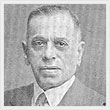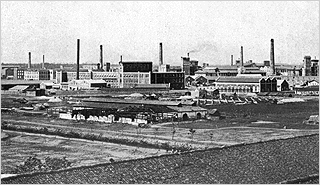Ebrahim Baronets: Difference between revisions
imported>Raveem Tahir |
imported>Raveem Tahir |
||
| Line 16: | Line 16: | ||
Over the years, the Currimbhoy Ebrahim name has become synonymous with philanthropic donations for scholarships, institutes and universities, similar to the activities of the other [[Indian]] baronets. The activities were mainly connected with [[Mumbai]]: | Over the years, the Currimbhoy Ebrahim name has become synonymous with philanthropic donations for scholarships, institutes and universities, similar to the activities of the other [[Indian]] baronets. The activities were mainly connected with [[Mumbai]]: | ||
* The Currimbhoy Ebrahim Khoja Orphanage, Baug-e Karim, 2, Altamorent Road, Mumbai, Maharashtra - 400026, India<ref>http://mha.nic.in/fd-ar0304/9.3Reported%20Associations%20for%202003-04%5CMaharashtra.htm</ref>. | |||
* The complex of the [[Cowasji Jehangir Hall]] and the [[Institute of Science]] was built by the British architect Wittet at a cost of 19 [[lakhs]] (1,900,000 [[Rupees]]), with 11 lakhs being contributed by Sir Currimbhoy Ibrahim and [[Sir Jacob Sassoon]]. The only other public hall being Town Hall, the new hall filled a vacuum in the city’s social life. At the inauguration of the complex, [[Lord Sydenham]] said: “Bombay is fortunate in the possession of so many good citizens who, recognizing that great wealth carries obligations, have come forward to assist in meeting the various growing needs of the city”<ref>National Gallery of Modern Art, http://www.ngmaindia.gov.in/mumbai_history.asp</ref>. | * The complex of the [[Cowasji Jehangir Hall]] and the [[Institute of Science]] was built by the British architect Wittet at a cost of 19 [[lakhs]] (1,900,000 [[Rupees]]), with 11 lakhs being contributed by Sir Currimbhoy Ibrahim and [[Sir Jacob Sassoon]]. The only other public hall being Town Hall, the new hall filled a vacuum in the city’s social life. At the inauguration of the complex, [[Lord Sydenham]] said: “Bombay is fortunate in the possession of so many good citizens who, recognizing that great wealth carries obligations, have come forward to assist in meeting the various growing needs of the city”<ref>National Gallery of Modern Art, http://www.ngmaindia.gov.in/mumbai_history.asp</ref>. | ||
* The Rahimtoola Currimbhoy School was constructed out of the donation of Rs.1,00,000 recieved through the | * The Rahimtoola Currimbhoy School was constructed out of the donation of Rs.1,00,000 recieved through the late Sir Currimbhoy Ebrahim, Second Baronet from the estate of the late Mr Rahimtoola Currimbhoy dated 1st April 1932<ref>http://www.bmccyberschools.org/rcmahimweb/about_our_school.htm</ref>. | ||
* The [[University of Mumbai]] offers the Sir Currimbhoy Education Scholarship for doctoral research, awarded on the basis of open competition<ref>http://chem.mu.ac.in/content/section/6/28/</ref>. | * The [[University of Mumbai]] offers the Sir Currimbhoy Education Scholarship for doctoral research, awarded on the basis of open competition<ref>http://chem.mu.ac.in/content/section/6/28/</ref>. | ||
Revision as of 11:33, 22 April 2007
(Currimbhoy) Ebrahim baronets of Pabaney Villa (India, 1911)
The Ebrahim Baronetcy of Pabaney Villa was created in the Baronetage of Great Britain and Ireland on July the 21st, 1911 for Sir Currimbhoy Ebrahim. King George V issued Letters Patent conferring the "dignity, state and degree" of a Baronet on Sir Currimbhoy Ebrahim of Bombay and to "the heirs male of his body lawfully begotten and to be begotten"[2].
In order to provide for the upkeep and dignity of the Baronetey, the then Governor General of India in Council enacted the Sir Currimbhoy Ebrahim Baronetcy Act, 1913. By this, considerable properties belonging to Sir Currimbhoy Ebrahim were settled upon the trustee to support the dignity of the hereditary title for the first baronet and his heirs, following the precedent set by the Cowasji Jehangir Baronetcy Act of 1911[3]. The first trustees included the first baronet and three officials of the Government of Bombay[2].
The Ebrahim baronetcy remains the only British hereditary title created for a Muslim (other Muslims with hereditary titles such as Baron Headley have been converts, and whilst numerous Muslims have had honours such as Knighthoods and Life Peerages conferred, these are for the lifetime of the holder only).
Philanthropy
Over the years, the Currimbhoy Ebrahim name has become synonymous with philanthropic donations for scholarships, institutes and universities, similar to the activities of the other Indian baronets. The activities were mainly connected with Mumbai:
- The Currimbhoy Ebrahim Khoja Orphanage, Baug-e Karim, 2, Altamorent Road, Mumbai, Maharashtra - 400026, India[4].
- The complex of the Cowasji Jehangir Hall and the Institute of Science was built by the British architect Wittet at a cost of 19 lakhs (1,900,000 Rupees), with 11 lakhs being contributed by Sir Currimbhoy Ibrahim and Sir Jacob Sassoon. The only other public hall being Town Hall, the new hall filled a vacuum in the city’s social life. At the inauguration of the complex, Lord Sydenham said: “Bombay is fortunate in the possession of so many good citizens who, recognizing that great wealth carries obligations, have come forward to assist in meeting the various growing needs of the city”[5].
- The Rahimtoola Currimbhoy School was constructed out of the donation of Rs.1,00,000 recieved through the late Sir Currimbhoy Ebrahim, Second Baronet from the estate of the late Mr Rahimtoola Currimbhoy dated 1st April 1932[6].
- The University of Mumbai offers the Sir Currimbhoy Education Scholarship for doctoral research, awarded on the basis of open competition[7].
Incumbents
Sir (Fazulbhoy[8]) Currimbhoy Ebrahim, 1st baronet

Currimbhoy Ebrahim, a Muslim, was born an Ismaili Dawoodi Bohra[10] on the 21st of October, 1840[11]. He went to Hong Kong in 1856 and set up E. Pabaney & Co. in 1857 at age seventeen. After becoming an industrialist with mercantile business in Bombay and Calcutta (India), Hongkong and Shanghai (China) and at Kobe (Japan)[1], Currimbhoy Ebrahim was knighted after a donation of 300,000 rupees for a museum commemorating a visit by the Prince of Wales and a contribution towards a statue of the Prince in Bombay[12].
Sir Currimbhoy Ebrahim was created a baronet on the 21st of July, 1911 and died on the 29th of May, 1924[2]. Clause 21 of his will stated: "Lastly it is my special desire that my son Mohamedbhoy on succeeding to the title of Baronet and every succeeding Baronet shall forthwith on such succession adopt the names of Currimbhoy Ebrahim and continue to do so as long as he holds the title."[2], thus making the holders commonly referred to as the Currimbhoy Ebrahim baronets, similar to the Readymoney and Jeejebhoy baronets.
Sir Currimbhoy Ebrahim was a freemason of a Bombay Lodge[13] and president of the Indian Merchants' Chamber in 1914[9]. He had had three sons[14] (his heir Mahomedbhoy, Ismail and one other)[2].
Sir Mahomedbhoy (or Mohamedbhoy[2]) Currimbhoy Ebrahim, 2nd baronet
Born on the 11th of September, 1867 and succeeded to the title on the 26th of September, 1924[11]. He owned roughly fifteen percent of the Bombay cotton mill industry in 1933[15]. Died on the 31st of March, 1928[2].
Sir Huseinlali (or Hussainbhoy[2]) Currimbhoy Ebrahim, 3rd baronet
Born on the 13th of April, 1903 and succeeded to the title on the 3rd of March, 1928. He migrated to Pakistan some time between 1947 and September, 1949 and was declared an evacuee under the new Bombay Evacuees Act in the same year, resulting, despite appeals, in the baronetcy trust being dissolved by the Indian Government[2]. Died on the 4th of March, 1952, aged 48[11]. Apart from his heir. his wife, Lady Amine Currimbhoy Ebrahim, and two daughters (Munira Fazal Chinoy and Mumtaz Mohamed Rahimtoola) survived him[2].
Sir Mahomed (Fazalbhoy[2]) Currimbhoy Ebrahim, 4th baronet
Born on the 24th of June, 1935. Succeeded to the title on the 4th of March, 1952. Current incumbent[11].
Heir apparent
The heir apparent is Zoolfikar Ali (?-)[2].
References
- ↑ 1.0 1.1 http://www.harappa.com/photo2/bo3.html
- ↑ 2.00 2.01 2.02 2.03 2.04 2.05 2.06 2.07 2.08 2.09 2.10 2.11 Supreme Court of India, 1978, Fazalbhoy Currimbhoy etc v. official trustee of Maharashtra & ors, etc [1978] INSC 254; [1979] 2 SCR 699; [1979] 3 SCC 189; AIR 1979 SC 687 (12 December 1978) http://www.austlii.edu.au/~andrew/CommonLII/INSC/1978/254.html
- ↑ Page 7. British India (in Review of Legislation, 1913; British Empire), Courtenay Ilbert, Journal of the Society of Comparative Legislation, New Ser., Vol. 15. (1915), pp. 7-13. Stable URL: http://links.jstor.org/sici?sici=1479-5973%281915%292%3A15%3C7%3ABI%3E2.0.CO%3B2-O
- ↑ http://mha.nic.in/fd-ar0304/9.3Reported%20Associations%20for%202003-04%5CMaharashtra.htm
- ↑ National Gallery of Modern Art, http://www.ngmaindia.gov.in/mumbai_history.asp
- ↑ http://www.bmccyberschools.org/rcmahimweb/about_our_school.htm
- ↑ http://chem.mu.ac.in/content/section/6/28/
- ↑ Page 570. Negotiating the Lucknow Pact, Hugh F. Owen, The Journal of Asian Studies, Vol. 31, No. 3. (May, 1972), pp. 561-587. Stable URL: http://links.jstor.org/sici?sici=0021-9118%28197205%2931%3A3%3C561%3ANTLP%3E2.0.CO%3B2-J
- ↑ 9.0 9.1 http://www.imcnet.org/aboutIMC_pastpresidents.asp
- ↑ Page 423. South Asian Muslims in Hong Kong: Creation of a 'Local Boy' Identity, Anita M. Weiss, Modern Asian Studies, Vol. 25, No. 3. (Jul., 1991), pp. 417-453. Stable URL: http://links.jstor.org/sici?sici=0026-749X%28199107%2925%3A3%3C417%3ASAMIHK%3E2.0.CO%3B2-V
- ↑ 11.0 11.1 11.2 11.3 http://www.angeltowns.com/town/peerage/baronetse.htm
- ↑ Page 163. Indian Millowners and Indian Nationalism before 1914, A. P. Kannangara, Past and Present, No. 40. (Jul., 1968), pp. 147-164. Stable URL: http://links.jstor.org/sici?sici=0031-2746%28196807%290%3A40%3C147%3AIMAINB%3E2.0.CO%3B2-8
- ↑ History of Scottish Freemasonry in India: 1838 - 2001, http://www.geocities.com/dglindia/hist1.htm
- ↑ Page 59. TRADE, DEVELOPMENT AND MULTIPLE LAYERS OF LAWMAKING: COPYRIGHT, TRANSLATIONS AND RELATIONS BETWEEN BRITAIN AND INDIA, 1880-1914, Lionel Bently. http://www.law.ucla.edu/docs/bentlyindiaucla.pdf
- ↑ Page 643. Industrialization in India before 1947: Conventional Approaches and Alternative Perspectives, Rajnarayan Chandavarkar, Modern Asian Studies, Vol. 19, No. 3, Special Issue: Papers Presented at the Conference on Indian Economic and Social History, Cambridge University, April 1984. (1985), pp. 623-668. Stable URL: http://links.jstor.org/sici?sici=0026-749X%281985%2919%3A3%3C623%3AIIIB1C%3E2.0.CO%3B2-G
